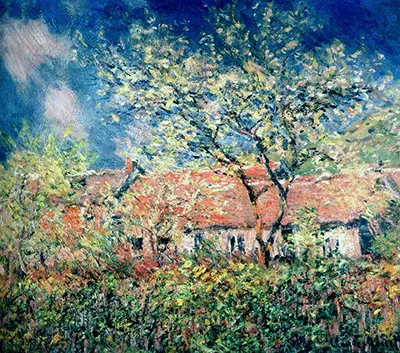This beautiful landscape painting captures the essence of Impressionism in its harmonious colours and dreamlike figures, in the freshness and immediacy of its depiction, and in the way that it is able to conjure up strong emotions in the viewer's mind and heart.
Like the majority of his works, Monet painted Springtime at Giverny al fresco or as the French Impressionists called the technique, 'en plein aire', though he perhaps took the canvas with him back to the studio to touch it up and perfect it there. See also his Giverny in Springtime.
Throughout the 1880s and 1890s, Monet painted several works that depicted Giverny, and several of them have the same title: Springtime at Giverny. Again, this is something that is typical of the way in which Monet worked. He liked to keep coming back to a landscape, a bridge, a building, or a particular pond or tree and to paint it numerous different times (e.g. Haystacks) to see how different it looked in different light effects as the seasons and the hours changed.
For example, he created dozens of different views of Rouen Cathedral and his Waterlilies series is one of the most famous sets of paintings of the nineteenth century. Giverny is a rural location in the North of France, and Monet loved to paint landscapes from this part of the country. Another example is his set of paintings of various points along the coast of Normandy.
Like very many of Monet's works of art, Springtime at Giverny is an oil on canvas painting. The way that Monet applied the oil to the canvas was very particular. As mentioned above, Impressionists preferred to paint out in the open air, with the landscape that they were painting right in front of their eyes.
For this, they took advantage of the recent invention of oil paints in tin tubes, which were much easier to transport around the countryside that the arrays of powders and oils that were traditionally used by artists to mix their own paint pigments in the studio.
Impressionists like Monet also favoured the use of a special portable type of easel known as a box easel which could be folded up into a sort of wooden briefcase as the artist strolled through the countryside in search of a good landscape to paint. Those most related to the work of Monet would include JMW Turner, John Singer Sargent, Thomas Gainsborough and John Constable.
Using tubes of paint for works such as Springtime at Giverny enabled Monet to create very vivid works of art. This is because he could take his brush and apply the paint straight from the tin tube onto the waiting canvas to preserve the utmost vividity of its hue.
Rather than mixing his oils, Monet overlaid them. Sometimes, he painted wet paint onto wet paint, whilst at other times he waited for the first layer of paint to dry before adding in some details with a small brush.
Often, he would apply the paint in broad strokes first before adding fineness and clarity with thinner little strokes on top of these broad ones. Traces of all aspects of this style can be seen in the painting currently under discussion: Springtime at Giverny.
The style of impressionists like Monet show just how far art had moved on from Renaissance masters like Michelangelo, Leonardo da Vinci, Masaccio and Sandro Botticelli.


